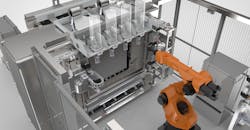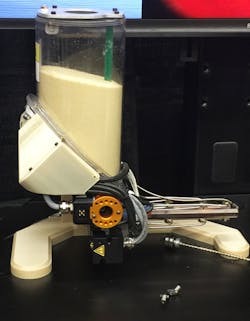Welcome to the Future: Stratasys Just Turned 3D Printing on its Head
Last month, 3D printer-maker Stratasys gathered a crowd of tech writers and investors to its U.S. headquarters to unveil a new additive manufacturing concept designed to literally turn the technology on its head.
The event started with a bold welcome.
"Welcome to the future," said Scott Crump, Stratasys founder and CIO, to the crowd, "[This is] the future of FDM, of 3D printing, and of manufacturing."
The gathering—and Crump's future"—was centered around two new breakthrough innovations to the company's signature technology, Fused Deposition Modeling (FDM), both of which signal a major departure from the system as we know it today.
"We knew we needed a step change. We couldn't just take what we had and just incrementally improve it; we had to start over."
Combining Stratasys' 30 years' experience in the 3D business with the efforts and cumulative brain power of Ford, Boeing, and Siemens, the company show us two new 3D printing units in action—the Infinite-Build 3D Demonstrator, which can (theoretically) print objects with unlimited z-axis; and the Robotic Composite 3D Demonstrator, which attaches a print head to an industrial robot to produce complex composite parts without the need of support materials.
The releases are wildly different that anything Stratasys has ever produced before and may offer an interesting clue to how the future of the industry (and the company) may look.
FDM: A Primer
Fused Deposition Modeling, which was invented by Crump in his kitchen back in 1989, is probably what you imagine when you think of 3D printing.
Traditionally, the technology uses a 3-axis deposition head to melt spool-fed tubes of thermoplastic material and extrude the molten plastics in thin layers on a heated build-plate, building new parts from scratch slowly upwards, layer by careful layer.
By Crump's estimation, it is the technique used by about 90% of the 3D printers in use today.
The system—while simple and stable enough to build impressive objects and tools—has always presented a few fundamental limitations.
First, most professional-grade FDM machines deposit materials in a closed, heated oven to help each layer properly melt and adhere. This presents an obvious limitation to the size of objects that can be printed—if you want to print a car in one pass, for instance, you would need a printer the size of a car.
Next, the quality of the parts have been limited to the capabilities of the deposition heads. Even under extremely controlled conditions, it is difficult to maintain a temperature and deposition rate consistent enough to meet some production standards in highly-regulated industries like aerospace.
And then, there's speed. If you have ever watched a 3D printer run, you know how maddeningly slow it can seem. In the end, the general process can be much faster than traditional methods, but watching it happen is the manufacturing equivalent of watching water boil.
Finally, the functionality of FDM parts is limited by the single-material nature of FDM. Whereas other 3D printing systems have made a lot of progress in the multi-material, multi-color capabilities, FDM has remained single material, single color.
These limitations have always kept FDM sort of in the background of manufacturing—creating robust prototypes, innovative new jigs and fixtures, molds, and the like, but final part production has always been just out of reach. Until now.
Today, this Infinite-Build system has overcome all four of these barriers and limitations in one fell swoop.
3D Printing: Reimagined
The Infinite-Build 3D Demonstrator began around five years ago with a conversation between Boeing and Stratasys.
"They told us, 'someday we will need to be able to print a part the size of this table'," recalled Dick Anderson, senior vice president of R&D at Stratasys.
This conversation drove Anderson's team to completely re-examine their technology from the ground up to figure out what it would take to meet this kind of demand.
While it was clear, he said, that the company's current suite of printers was adequate for the needs of today if Boeing's request was any sign, they were not up to the demands for the future.
"As we looked at the requirements and what is really needed in the future, we knew we needed a step change," Anderson explained. "We couldn't just take what we had and just incrementally improve it; we had to start over."
Specifically, they needed a system that could overcome the four major roadblocks to FDM: They needed a printer that could print larger parts in multiple materials consistently and accurately, faster than ever before.
And there, the inspiration was born.
To Infinity, and Beyond
Conceived specifically for the aerospace and automotive industries, the Infinite-Build system fundamentally alters the basic "rules" for FDM printing, starting with those space-limiting ovens.
"We understood that the oven is only need in the actual build plane," Anderson said. "It's not actually needed at all once the part has reached its critical temperature."
Also, as its zero-G tests have proved, FDM doesn't actually need gravity to work either.
So there was the inspiration: just tip the whole system over and open the oven doors. Build the whole thing out instead of up.
"We said, let's tip it on its side. Let's create an oven that is just for the build plane and have the whole part come out of that build plane," Anderson explains. "That will give us our infinite build."
In theory, the system can print objects of any length, as long as the X and Y axes fit into the 4 by 2.5 ft chamber. The Z-axis of the part just slides right out the back door as far as it needs to go. This means the system is capable of printing anything from customized car arm rest to an entire aircraft interior panel in one job.
To beat the other FDM issues, the system takes an entirely new approach to material deposition.
"Our number one failure point has always been the extruder itself," Anderson said. "Having a heated tube liquefier as the only item building makes it a central point of failure."
So Anderson turned to Crump and his Skunk Works innovation lab to come up with a new solution.
The result is an all-new screw-type extruder that feeds flakes of thermoplastic materials to the head in a controlled, repeatable, and traceable process that is designed to guarantee consistency and accuracy throughout the build, however long it goes.
To enhance that consistency, the new deposition heads have been equipped with a host of features, sensors, and processes to keep each build in spec.
"The extruder is swappable in an automated fashion," Anderson says. "It also has a pressure sensor built into the tip so we can monitor the extruder to see when it is going to have a problem."
The advantage there, he said, is that the system is now able to monitor its processes in real-time to detect and address any issues it finds before they become actual problems.
As far as speed, he said, that's easy. The new design increases total build speed by about 10x.
Welcome to the Future
If this machine is acting as the flagship for a new era in Stratasys' evolution, it is making a strong point.
For 30 years, Stratasys has defined the 3D printing industry with its lines of complete additive manufacturing systems—an wide range of complex appliances capable of building anything the user can dream up.
But this is the first machine to break out of that appliance mold, finding a novel application that puts the users' needs and real-world demands first.
"This is just the beginning—it's the beginning of offering new, exciting solutions and new applications in 3D printing," Crump told us. "This is definitely a very exciting time to be in the industry."
About the Author
Travis Hessman
VP of Content, Endeavor Business Media
Travis Hessman is the VP of Content for Endeavor Business Media. Previously, Travis was the Editor-in-Chief for Industry Week and New Equipment Digest as well as the Group Editorial Director for Endeavor's Manufacturing Group.
He began his career as an intern at IndustryWeek in 2001 and later served as IW's technology and innovation editor. Today, he combines his experience as an educator, a writer, and a journalist to help address some of the most significant challenges in the manufacturing industry, with a particular focus on leadership, training, and the technologies of smart manufacturing.



